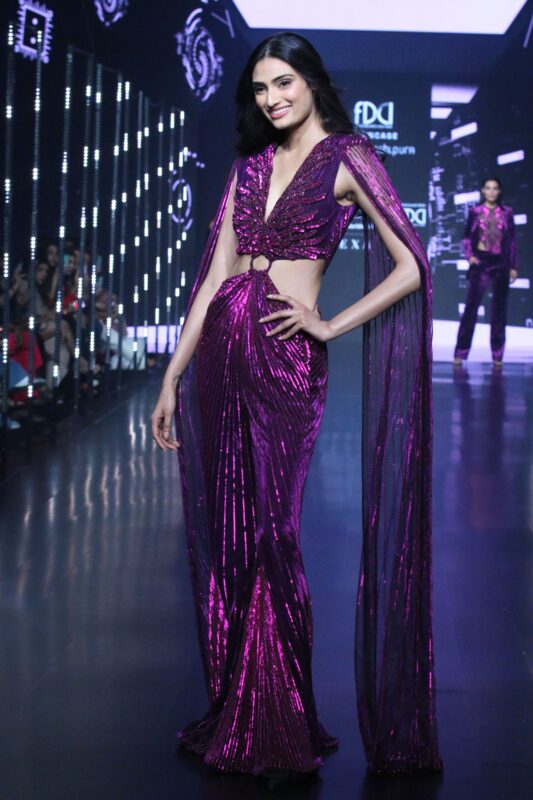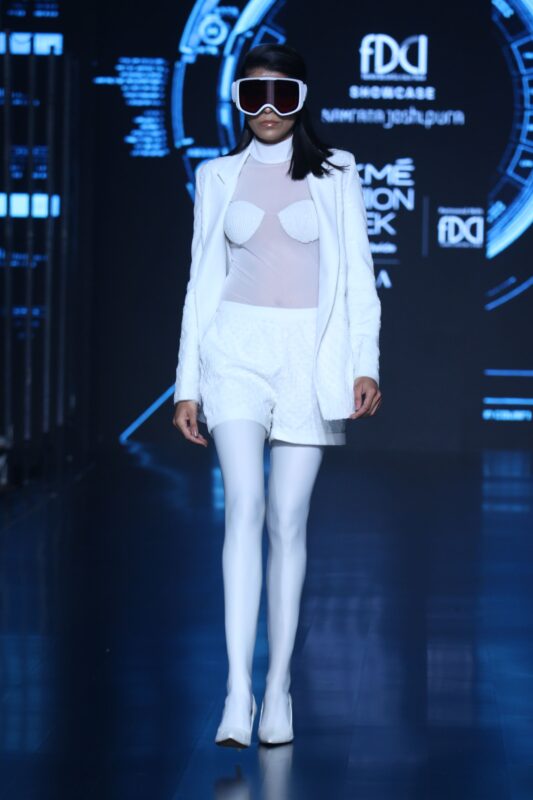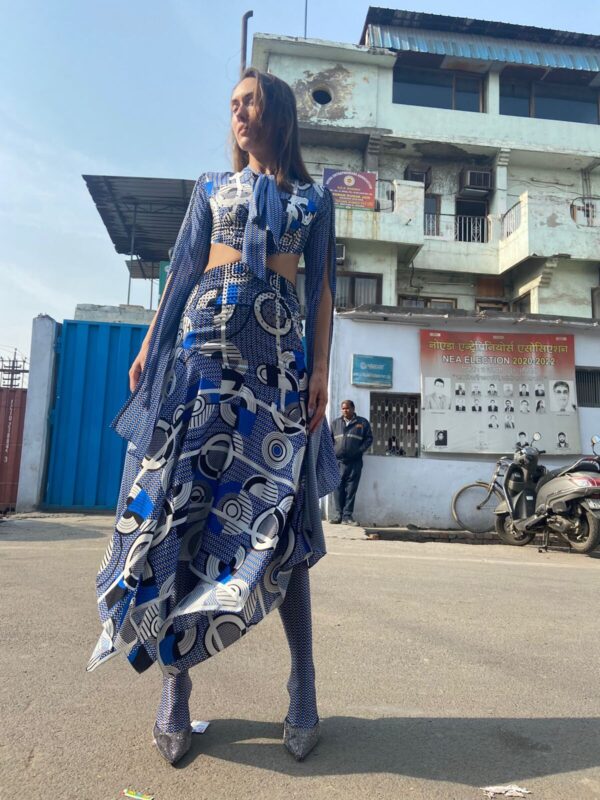“AI (Artificial Intelligence) is the muse this season. I was thinking about how we might dress in a world that disintermediates the human. What does that loss make us yearn for? Nostalgia. Perhaps, a post-modern disco elegance. As always, I celebrate colour,” says Namrata Joshipura.
The palette consisted of cerulean blues, forest greens and a saturated classic red. For a change, black is playing a supporting rather than leading role in her showcase at the Fashion Design Council of India x Lakme Fashion Week (FDCIxLFW) 2023.
This season, she is paying an ode to artificial intelligence, in her line titled “The First Order”.
Namrata has been navigating the choppy waters of the fashion world with ease, never deviating from her sole purpose — western alternatives for an Indian woman, who likes to wear something bold and also boast of traditional handwork.
Her play with drapes, and cut-outs, can be seen in the way she dressed the statuesque Athiya Shetty in a shimmering deep wine tonal jumpsuit.
Besides Namrata, who has paid a visual homage to AI, Indian designer duo Falguni and Shane Peacock are using IBM’s cognitive tool Watson. This enables them to create a blueprint by predicting the future of Bollywood fashion. This is executed by combining an analysis of more than 6.5 lakh images of runway presentations at London, Paris, Milan and New York, haute couture.

IBM Watson analysed 5,000 Bollywood driven images, 3,000 of them fashion ones from movie posters from the 70s onwards. They gathered hues, shapes and prints to know what will be the future of Bollywood fashion. This would have been humanly impossible.
But that is not all. Some are offering AI to give personalised experience to buyers. The Label Life, a lifestyle brand, sells trend-based pieces which are curated by celebrity style editors — Sussanne Khan, Malaika Arora Khan and Bipasha Basu.
The online retailer Myntra sells a line of tees designed by their in-house AI platform Rapid.
However, what Marchesa, an international womenswear brand, attempted was unprecedented. They worked with IBM and again Watson in 2016 for the MET gala.

The project came about after seeing the Manus x Machina: Fashion in the Age of Technology theme of an exhibition. Marchesa worked with Inno360 and IBM Research-Almaden skimming through fabric options to pinpoint on the appropriate LED-one to design the ensemble. Watson gave “cognitive insights” and the dress was worn by supermodel Karolina Kurkova.
For Delhi-based designer Namrata, fabric is often just a vehicle for intricate embroideries. In her collection this time, there has been a use of heavy crepes, luxe satins, and shimmer spandex. The high shine supports the theme of the show which is about AI and envisioning the future.
“These days, the counterpoint to occasion wear is athleisure and streetwear and we can already see that on the ramp. How many $300 sneakers and yoga pants can one buy? I love high glam and how it can shift your feeling when wearing one of my dresses or jumpsuits. Our garments fit like a glove. Our woman is fit, unabashed and supremely poised in our body-con outfits,” she adds.
The strength of the brand lies in its continuity and to survive in a market that has turned volatile post-covid requires fortitude.
“In many ways, one’s essential design DNA cannot change. I am an occasion wear designer at heart, but yes, the ‘journey’ must continue for commercial reasons as well,” she affirms.
She believes that besides the obvious catch-up in bridal wear demand post Covid, the market has seen bouts of ‘revenge buying’ in the contemporary sector. As a result, sales have spiked every month, and are generally strong in India. The consumer is still slightly tentative about discretionary spending, but has an open wallet for ‘must-have’ items.

“Fundamentally, you must have a love for design. Aesthetics should imbue every aspect of your life to continue on this trail,” she adds.
However, on the practical side, the fashion game in India is vertical, you are a designer, manufacturer, and retailer.
“You need to master the skills involved in all three or you will not be able to run a financially viable business. This is an ultra–marathon,” she confesses. She would know as she is a trekker and marathon runner. She climbed Mount Kilimanjaro, completed the Boston Marathon, which is considered the most challenging track.
Namrata is always open to venture or strategic partners as designers shift grow with corporate investments. She believes there is a lot she can do in terms of a new diffusion line.
Currently, the constraint is less capital and more management bandwidth.
The need is for smarter, commercially-savvy brand builders in the industry. Her piece of advice for those venturing into the world of patterns and designs is “don’t bother getting into this industry if you don’t have the stamina, discipline and passion”.
AI can help reduce waste, and increase profits as well as innovate the supply chain. You also know which designs will work as you have customer data, so you do not make what does not sell. Rather concentrate on what will. It can perform better. You will not need so many hands, plus machines and robots can stitch fabrics, detect problems, and ensure quality. Now you can also use algorithms where there are virtual personal stylists, who will suggest ensembles based on what suits your body type.
Van Heusen retail has a “virtual trial” mirror, you can see how clothes look on you by scanning the barcode and standing in front of the mirror and the virtual garments will be a reflection. There are also smart mirrors, so you know how you will look without trying on clothes. Then come interactive mirrors in fitting rooms where you can reach a stylist as well as alter the lighting.
“This is frankly the future and it will bring an ease in the style world,” says Namrata.





